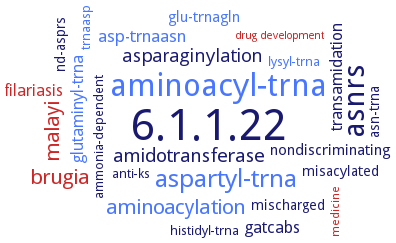6.1.1.22: asparagine-tRNA ligase
This is an abbreviated version!
For detailed information about asparagine-tRNA ligase, go to the full flat file.

Word Map on EC 6.1.1.22 
-
6.1.1.22
-
aminoacyl-trna
-
asnrs
-
aspartyl-trna
-
malayi
-
brugia
-
aminoacylation
-
amidotransferase
-
asparaginylation
-
asp-trnaasn
-
glutaminyl-trna
-
gatcabs
-
filariasis
-
transamidation
-
nondiscriminating
-
glu-trnagln
-
mischarged
-
misacylated
-
asn-trna
-
nd-asprs
-
ammonia-dependent
-
anti-ks
-
lysyl-trna
-
trnaasp
-
histidyl-trna
-
medicine
-
drug development
- 6.1.1.22
- aminoacyl-trna
- asnrs
- aspartyl-trna
- malayi
- brugia
- aminoacylation
-
amidotransferase
-
asparaginylation
- asp-trnaasn
- glutaminyl-trna
- gatcabs
- filariasis
-
transamidation
-
nondiscriminating
- glu-trnagln
-
mischarged
-
misacylated
-
asn-trna
- nd-asprs
-
ammonia-dependent
-
anti-ks
- lysyl-trna
- trnaasp
-
histidyl-trna
- medicine
- drug development
Reaction
Synonyms
AS-AR, AsnRS, Asparagine synthetase A, Asparagine translase, asparagine tRNA synthetase, Asparagine--tRNA ligase, Asparaginyl transfer ribonucleic acid synthetase, Asparaginyl transfer RNA synthetase, asparaginyl tRNA synthetase, Asparaginyl-transfer ribonucleate synthetase, asparaginyl-transfer RNA synthetase, Asparaginyl-tRNA synthetase, Asparagyl-transfer RNA synthetase, class IIb asparaginyl-tRNA synthetase, More, NARS, NARS2, NRS, Potentially protective 63 kDa antigen, PYRAB02460, Synthetase, asparaginyl-transfer ribonucleate
ECTree
Advanced search results
Expression
Expression on EC 6.1.1.22 - asparagine-tRNA ligase
Please wait a moment until all data is loaded. This message will disappear when all data is loaded.
engineering of aspartyladenylate, AspAMP, specificity into asparaginyl-tRNA synthetase, AsnRS, whose substrate is asparaginyl-adenylate by CPD method, that uses a polar-hydrogen energy function for protein interactions and a coulomb/accessible surface area model for solvent effects, method development, overview. Application of an all-atom energy for protein interactions and a residue-pairwise generalized Born model for solvent effects, overview. The conformations and interactions are well maintained in molecular dynamics simulations and the sequences have an inverted specificity, favoring AspAMP over AsnAMP
-
fibroblast growth factor 2, FGF2, that functions in intracellular signaling in bone development, induces the enzyme in MC3T3-E1 preosteoblast cells more than 900fold, the overexpression of NARS significantly increases the proliferation of both the MC3T3-E1 and the primary mouse calvarial cells, overview
-


 results (
results ( results (
results ( top
top





